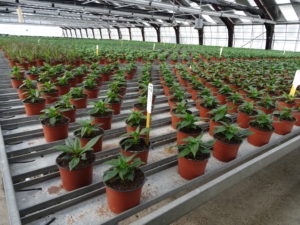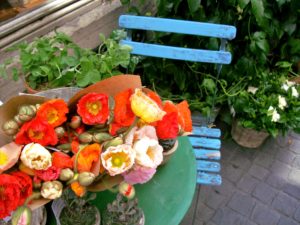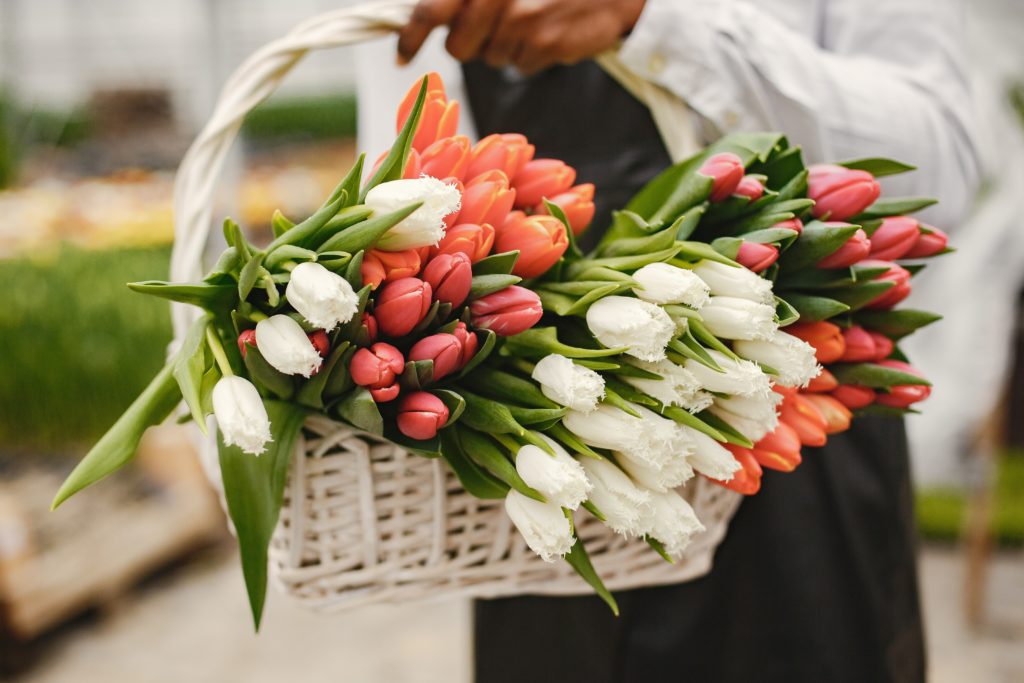Asparagus in January or strawberries in February. It’s become very obvious ― in order to produce these products, temperatures have to be significantly warmer than here, be it outdoors or in a greenhouse. This means that a number of fruits and vegetables haul a large backpack of CO2 due to cultivation and transport. But what about flowers? Where do tulips originate in December? Or all those plants and shrubs blooming way too early, waving cheerfully at us from the stores?
Buy me, I am spring! I’ll bring color and vibrancy to your home. After months of monotonous brown and gray, it is understandable that we crave cheery colors. Yet when we peer outside, we realize this is probably akin to strawberries in February. The CO2 calculation can’t add up, can it? That’s not entirely true, because we can at least make matters much more climate-friendly!
 What alternatives do we have?
What alternatives do we have?
This is my friend Alex. He runs a small garden and floristry center not far from Winterthur. A plant manufactory, as he calls it. And although Alex is a big fan of the punk rock band “Die Toten Hosen”, there is nothing dead in his greenhouses.
Alex and his wife are true professionals and have been running their nursery and flower shop as a family business for over 15 years. My own thumbs aren’t quite as green, so I turned to them for a Q&A on plants and climate.
During the insightful behind-the-scenes visit, I marvel at how complex the day-to-day business of seeds, seedlings, plant raising, cut flowers, houseplants, herbs, shrubs, small trees, soil and fertilizer is. And how difficult it is to earn living while still protecting our environment and climate.
Alex, who loves to brood over dirt, as he says, concisely outlines the problems to me. He also points out solutions to our dilemma.
The most climate-relevant issues are quickly identified.
Plants from here instead of there
 The majority of plants offered in this country come from intensive cultivation in various countries. As with all mass production, this consumes a large amount of resources such as water and energy. And a lot of waste is produced. To ensure that the plants are already in bloom when they arrive at the garden center, they are produced out of season in huge greenhouses and then transported all over Europe by truck.
The majority of plants offered in this country come from intensive cultivation in various countries. As with all mass production, this consumes a large amount of resources such as water and energy. And a lot of waste is produced. To ensure that the plants are already in bloom when they arrive at the garden center, they are produced out of season in huge greenhouses and then transported all over Europe by truck.
Alex produces 90% – around 100,000 plants a year – on his own farm. In the event of extreme weather, it’s a risk, because growth can only be influenced or delayed to a limited extent. However, his motto, “Plants from here, instead of there” means a significant saving of resources and thus significantly lower CO2 emissions. The farm is constantly monitored by an energy agency and is gradually being converted to climate-friendly technologies such as geothermal probe heating.
What he does not produce himself, such as herbs, he purchases from specialized family nurseries in the region only. The functioning network ensures short transport routes and consistent quality.
Growing plants in your own garden
Instead of consuming ready-made plants, you can also sow seeds and grow plants yourself. Bulbs of tulips, hyacinths or alliums are perennial and can be easily overwintered. A rich selection of available seeds allows to make a garden climate-friendly and varied. ProSpecieRara plants are also available. A visit to Wildegg Castle near Lenzburg (AG) is well worthwhile as the site proves how wonderful such a garden can look.
CO2 can also be saved when it comes to soil. Although the extraction of peat is banned in Switzerland, it is still permitted in other European countries. As a result, many thousands of tons are imported each year, and most of it is used unnecessarily in private gardening.
The Swiss market leader Ricoter offers a whole range of soils peat-free and processed. The soils in blue packaging or specially marked packages are produced in Switzerland. The soils without labeling, however, are produced in Germany and transported to Switzerland by truck.
But what about those tulips?

Cut flowers are indeed the most vexed issue when it comes to climate protection. But if you don’t want to do without that bouquet for Valentine’s Day, Mother’s Day or other events, you should make sure to buy flowers from regional or climate-neutral cultivation. Good nurseries also ensure that cut flowers are almost 100% recycled. And seasonally you can switch to self-pruning plantings.
How to grow and bloom in a more climate-friendly way
It’s simple ― less mass-produced, more homegrown. Plus careful selection of the nursery and plants, flowers and soil when purchasing. This allows us all to have a more climate-friendly yard or balcony garden. And the more consumers demand appropriate garden products, the greater the supply will become.
An article by Heinz Fehlmann


 What alternatives do we have?
What alternatives do we have?